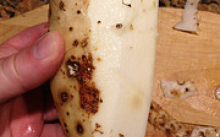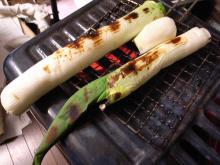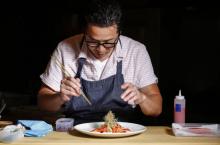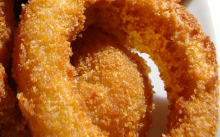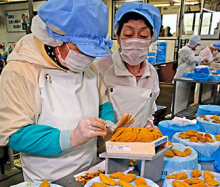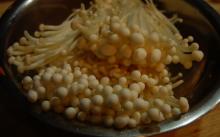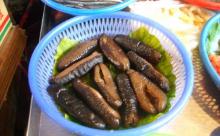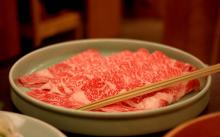Discover Nagaimo Yam: (nutrition & Health Benefits)
Discover Nagaimo Yam: (nutrition & Health Benefits)
The nagaimo yam (a.k.a. Dioscorea opposita or Shan Yao) has gained significant popularity as a healthy side dish to add to any Asian-themed meal. In traditional Japanese cuisine, this yam is typically eaten raw, and when grated it takes on a jelly-like consistency to put as garnish on soup noodles.
Although it is called a "yam", it bears very little similarity or relation to the sweet potatoes known as yams in North American cuisine. It is also often used in stews as well as various stir-fry applications, and can be eaten boiled, baked, mashed or fried.

 by geraldford - Peeled Yam
by geraldford - Peeled Yam
A Look at Nagaimo Yam Health Benefits
Numerous research studies and publications have highlighted the various health benefits of the nagaimo, as it has been used in a variety of Asian medicinal disciplines for centuries. This versatile yam has been used to treat a wide range of disorders and infirmities affecting the spleen, lungs, stomach, and kidneys. Some common ailments that the nagaimo yam is used to treat include:
- Diabetes
- Diarrhea/Loose stool
- Asthma
- Loss of appetite
- Dry cough or bronchial irritation
- Frequent urination
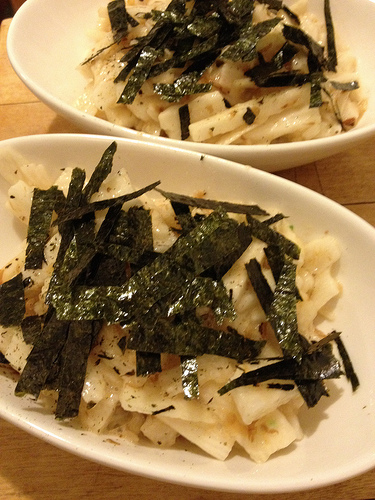
 by naotakem - Nagiamo Yam sliced raw to be eaten.
by naotakem - Nagiamo Yam sliced raw to be eaten.
Nutrition:
The nagaimo yam also contains allantoin, a naturally occurring chemical compound that can facilitate faster healing and recovery times through promoting the accelerated growth of healthy tissue. The jelly-like substance produced from grating the yam is applied topically to the skin in order to treat boils, ulcers and other aberrations. This yam is also commonly used to treat multiple kidney and gallbladder problems, as it is believed to contain nutrients that nourish these organs in particular.
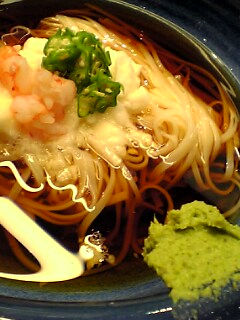
 by fo.ol - Nagaimo Yam shavings on Noodles
by fo.ol - Nagaimo Yam shavings on Noodles
Along with the nagaimo yam's many potential medicinal characteristics, it also contains several beneficial nutrients such as Vitamin B1 (thiamine), which promotes healthy mucous membranes, and Vitamin C, which fortifies the immune system. Another important nutrient found in this health-friendly yam is glutamine, which aids in the prevention of muscular breakdown and improves the metabolism of protein. So not only does this power-packed yam serve as a great complement to any Asian-themed dish, but it also provides a litany of health benefits that make it a great addition to your culinary lineup.
Another healthy Yam to look into is the Shirataki Yam Noodles(link) and yes, it is in Noodle format. It is also known as the miracle noodle for its weight loss properties.
What The Heck Are Negi Onions?
What The Heck Are Negi Onions?
The Negi onion is one of the most popular culinary ingredients in Japan. They are easily distinguished by their hollow tubular green tops and have elongated stems that never form into actual bulbs. In most cases, the Japanese people use Negi onions(scallions) for Nabemono and kushiyaki cuisines. These are one pot dishes prepared in a traditional non-meat style known as Yakitori. Both of them are indigenous cuisines specific to Japan.
Negi Onions experience vigorous growth in the spring and autumn, but they go dormant during the summer and winter seasons. This type of onion is rarely grown outside Japan. However, it is steadily becoming a special ingredient across various regions in Hawaii and California.
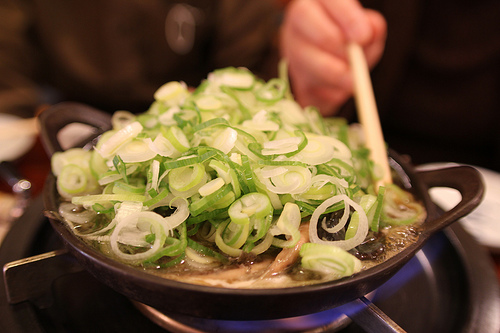
 by ivva - Negi onions use in popular noodle soup
by ivva - Negi onions use in popular noodle soup
Applications
Negi onions have a mild flavor that is savory and sweet. They are used in the same way as green onions, leeks and scallions. They have a tough texture that allows them to be cooked for long periods. In addition, their mild nature means they can be eaten raw. It is a popular vegetable toppings for many noodles dishes and hot pot dishes like Shabu Shabu.
Possible recipes
Negi onions are absolutely perfect for classic winter recipes such as heart soups, onion tarts and pot pies. They are also a great pizza or salad ingredient. Another way to use Negi onions is to cook them with butter or olive oil. This will bring out their savory taste which is great for fried fingerlings, mashed potatoes or gratins. Negi onions also pair well with various cream sauces such as cheddar cheese and béchamel.
The following are some of the most common recipes that include Negi onions:
- Miso Kimchi: This is soup made with Tokyo Negi.
- Misonegi or Negimiso: This is Japanese onion-miso paste or sauce.
- Roasted Japanese Negi onions
- Negi onions cooked in orange juice
- Cauliflower fried rice made with Negi onions.
You can choose a recipe that matches your tastes and preferences.
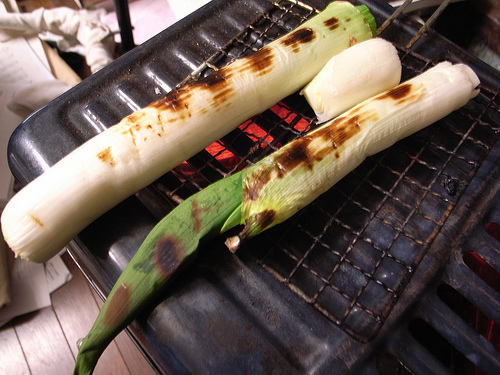
 by matsuyuki - Roasted Negi Onions
by matsuyuki - Roasted Negi Onions
Negi onions have become a popular culinary ingredient not only in Japan, but also in America and Europe. With each day, more and more people are starting to see its unique benefits.
Chef Sho Kamio: Master Of Japanese & Californian Cooking
Chef Sho Kamio: Master Of Japanese & Californian Cooking
Panko Crumbs And Its Ingredients And How Is Different From Breadcrumbs?
Panko Crumbs And Its Ingredients And How Is Different From Breadcrumbs?
Panko is the Japanese name used for bread crumbs. It has several characteristics that make it superior to America-style bread crumbs. In addition, panko crumbs can be used in a variety of culinary applications.
Panko Crumbs Ingredients
There are two main types of panko crumbs sold in stores. They are:
Using Quinoa As A Filling In Sushi
Using Quinoa As A Filling In Sushi
Kids are heading back to school soon, and you are probably thinking ahead on what to make your kids for lunch? It can be a difficult task as it can be time consuming and what is even more of a challenge is trying to provide some healthy ingredients.
One recipe we recommend you trying is Quinoa's sushi. Yes that is right, swapping out the rice for Quinoa!
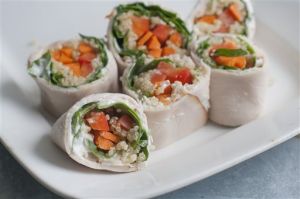
The Challenge Of Harvesting Sea Urchin
The Challenge Of Harvesting Sea Urchin
What Are Some Enoki Mushrooms Nutritional And Health Benefits?
What Are Some Enoki Mushrooms Nutritional And Health Benefits?
Enoki mushrooms are much more than your average fungus. They are long, slender stems with ultra-small caps and look very different then the ever so popular shiitake mushrooms. The native people of Japan consider them to be an elegant delicacy.
The mushrooms are crisp and have a mild sweet taste. In some regions of Japan, they are referred to as snow puffs. The mushrooms thrive in bouquet-like clusters and are usually eaten raw or they can be lightly cooked. It all depends on what you like.
Major nutrients and health benefits
Just like other fresh mushrooms, Enoki’s have low calorie levels. They are a huge source of proteins and complex carbohydrates. They are virtually fat and sugar free.
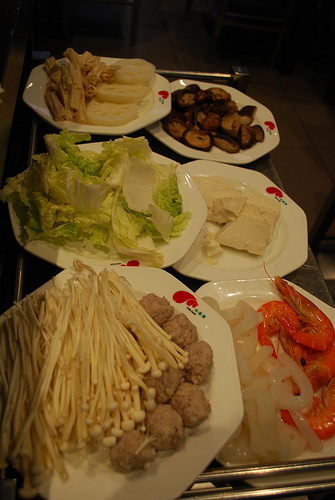
 by avlxyz -Enoki Mushrooms with other items for a shabu shabu hot pot
by avlxyz -Enoki Mushrooms with other items for a shabu shabu hot pot
Their high nutritional value and low fat levels have made them a popular delicacy in most parts of Japan and China. In addition, they are sweet and won’t cause you to add on weight. People with weight issues don’t have to worry about eating Enoki mushrooms because they will not affect their overall diet plan.
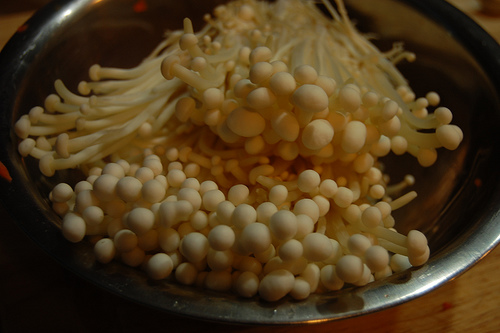
 by sleepyneko
by sleepyneko
Vitamins and minerals
Mushrooms usually contain high amounts of vitamin B and Enoki’s are no exception. They also contain other minerals such as potassium, phosphorus, copper, iron, zinc and selenium. These entire ingredients make Enoki mushrooms a very healthy meal. Our bodies need vitamins and minerals to perform cellular functions. Without them, we become more vulnerable to diseases and infections. A significant number of people in Japan consider Enoki mushrooms to be a health remedy.

 by tamakisono
by tamakisono
Healthy phytochemicals
The nutritional benefits of Enoki mushrooms are further increased by their healthy phytochemicals. It also has various potent antioxidant compounds that are good for the body. Another healthy ingredient that falls into this category is dietary fibre. Together with high amounts of beta-glucan, Enoki mushrooms help to reduce high cholesterol.
Due to its sweet taste and various health benefits, many people in America and Europe are beginning to embrace the delicacy.
Below is a demonstrating on how to prepare this mushroom.
Health Benefits In Sea Cucumbers?
Health Benefits In Sea Cucumbers?
What Meats And Vegetables To Use In Shabu Shabu?
What Meats And Vegetables To Use In Shabu Shabu?
A list of well-known Japanese dishes will include sushi and tempura, but shabu-shabu may not even make the cut, which is really a shame because it is one of easiest Japanese meals to prepare.
Sushi calls for a sushi master, and non-oily tempura also requires special techniques. But shabu-shabu isn’t as fussy - anyone with a pot and ingredients can make it. In another article, we explain how to make shabu-shabu broth and sauces, and in this article, we will share with you the ingredients that complete this tasty hotpot.
Shabu-Shabu Meats
Beef and pork are the most common meats used in shabu-shabu, but you may also use chicken and lamb.
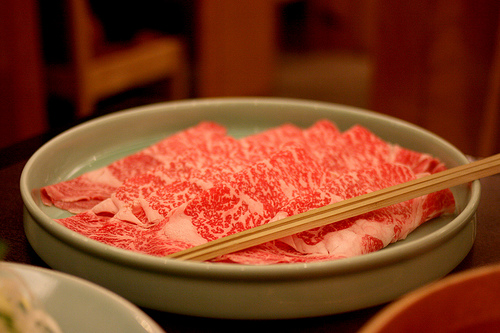
 by kadluba
by kadluba
Higher-end restaurants in Japan only serve beef for shabu-shabu. Marbled beef is the top choice, but some serve leaner cuts such as shoulder and loin.
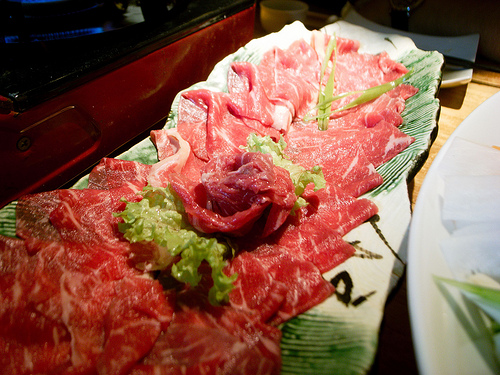
 by Jon slund - High quality beef
by Jon slund - High quality beef
The most important thing is that whatever meat you choose, it has to be thinly sliced because it has to cook very quickly. Shabu-shabu is the sound made by swishing the meat and vegetables in the broth and ideally, only a few swishes are required. You can get your butcher to cut your meat for you if you can’t find very thinly sliced meat.
Seafood
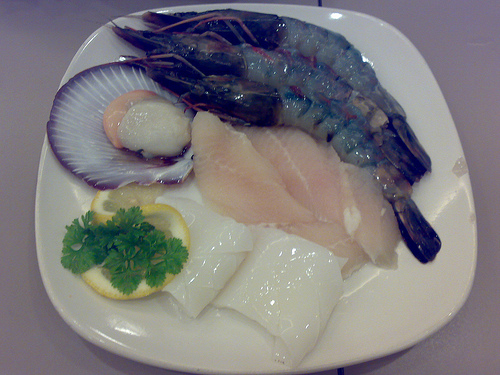
 by whologwhy - Seafood for Shabu Shabu
by whologwhy - Seafood for Shabu Shabu
Seafood is very popular in Shabu Shabu as well, some popular seafood are tiger prawns, squid and scallop.
Shabu-Shabu Vegetables
The vegetables are just as important as the meat because they will add their umami-rich juices to the broth that you will gratefully sip at the end of the meal. The Japanese say that you first eat with your eyes, so the trick is to choose vegetables with different colors. The ones most commonly used are Chinese cabbage, chrysanthemum leaves, negi (Japanese scallions), carrots, enoki mushrooms and shiitake mushrooms. You can also add tofu if you wish.
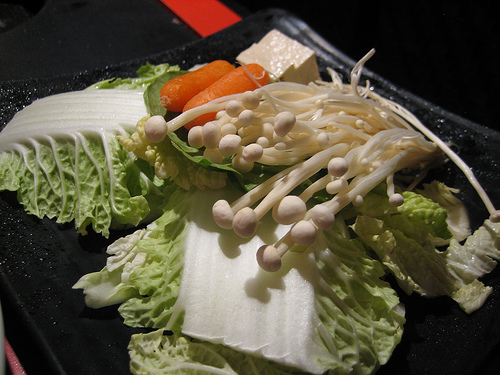
 by eekim
by eekim
As with the meats, it is essential that you cut the vegetables into smaller pieces so that they can cook fast. Some vegetables that require longer cooking times such as the stalks of the Chinese cabbage and carrots may need to be pre-boiled briefly. For decorative purposes, make cross-hatch cuts on the tops of the shiitake and slice the negi diagonally. If you cannot find Japanese vegetables, choose similar ones such as cabbage, and even lettuce, which some Japanese households include for the crunch. The Japanese are also big on presentation so arrange all of your ingredients in groups on platters for a neat, organized look.
Don't Waste the Scum!?
As you cook the meat and vegetables, scum will form on the broth and it is also important to remove this with a handheld strainer because you will drink this delicious, umami-packed broth with a starch after the meat and vegetables are gone. In Japan, this is called “shime” or the “closing.” Udon noodles are popular, as well as kishimen which are similar to udon but flat like fettucini. Some restaurants serve sticky rice cakes called mochi, and others, cooked rice. Whichever starch you choose, put it in the broth and let it heat up for a while before you eat the perfect ending to this delectable dish.



